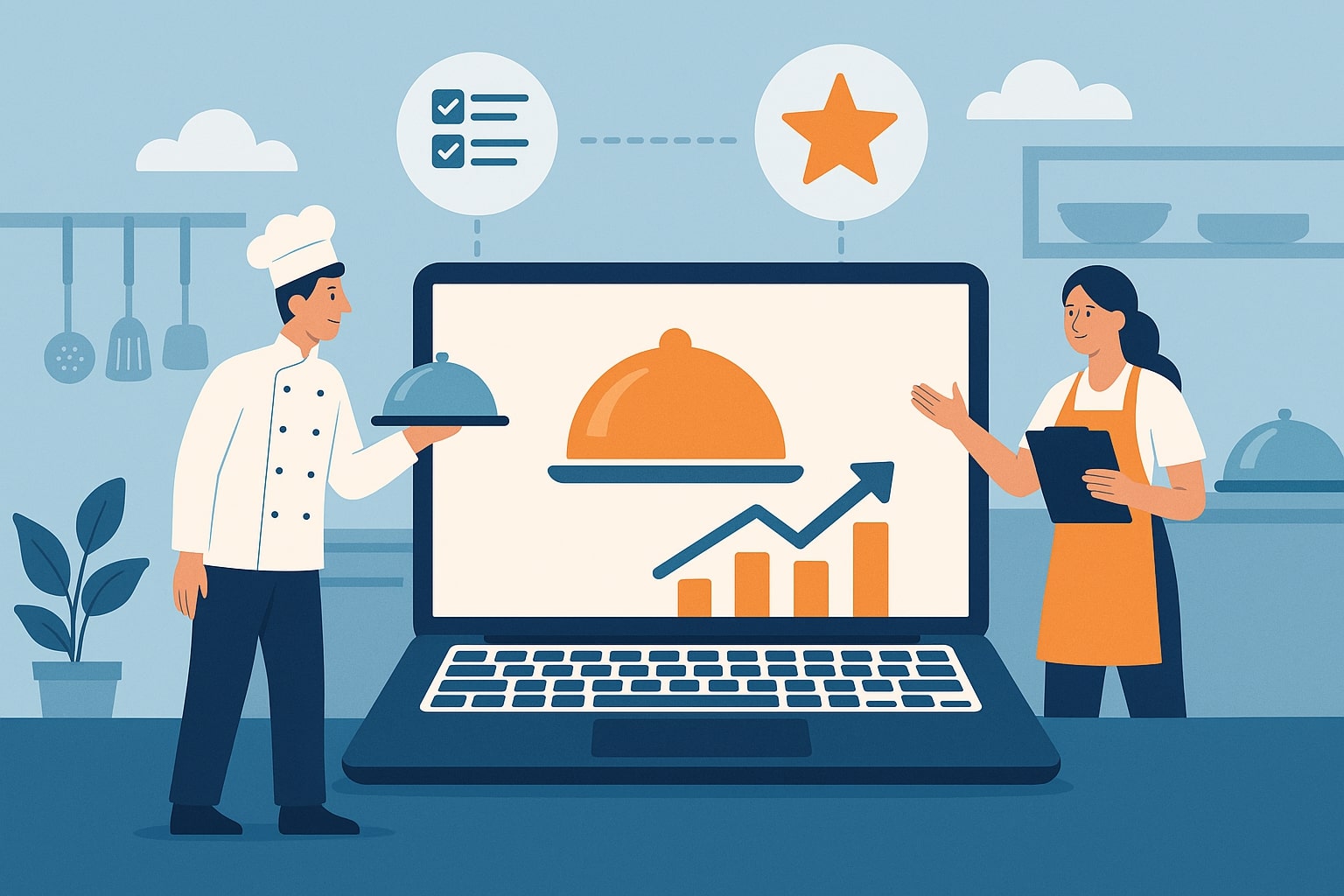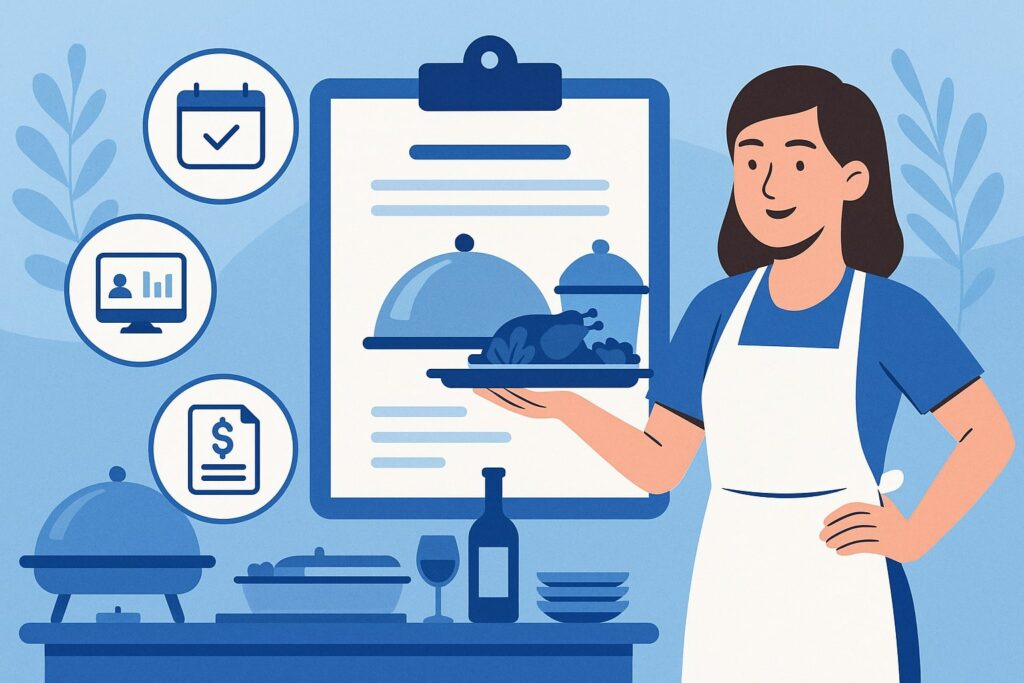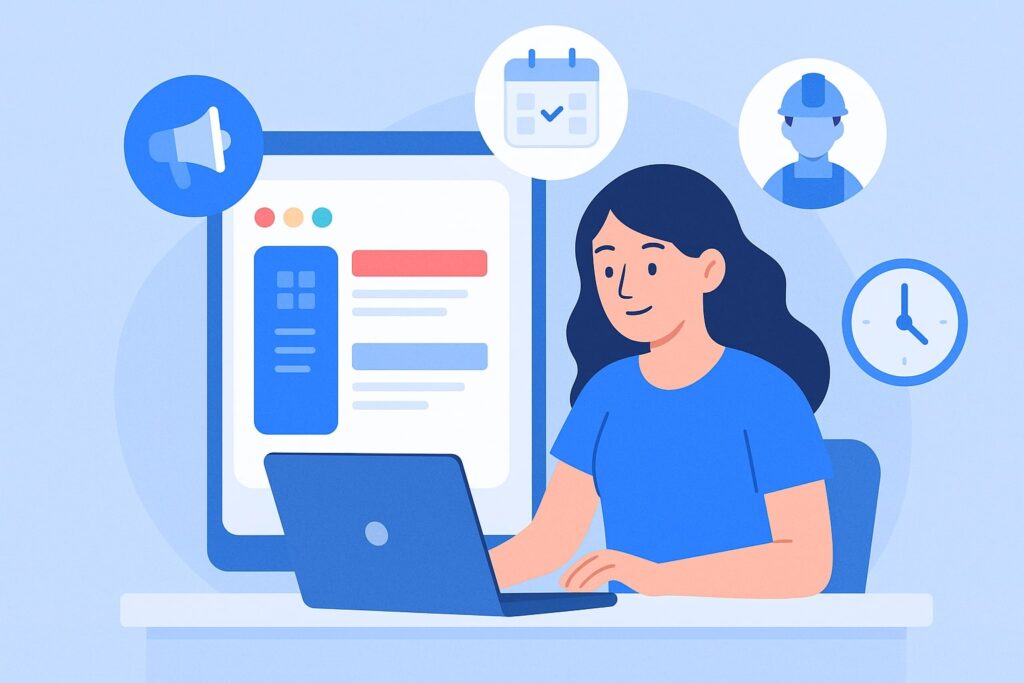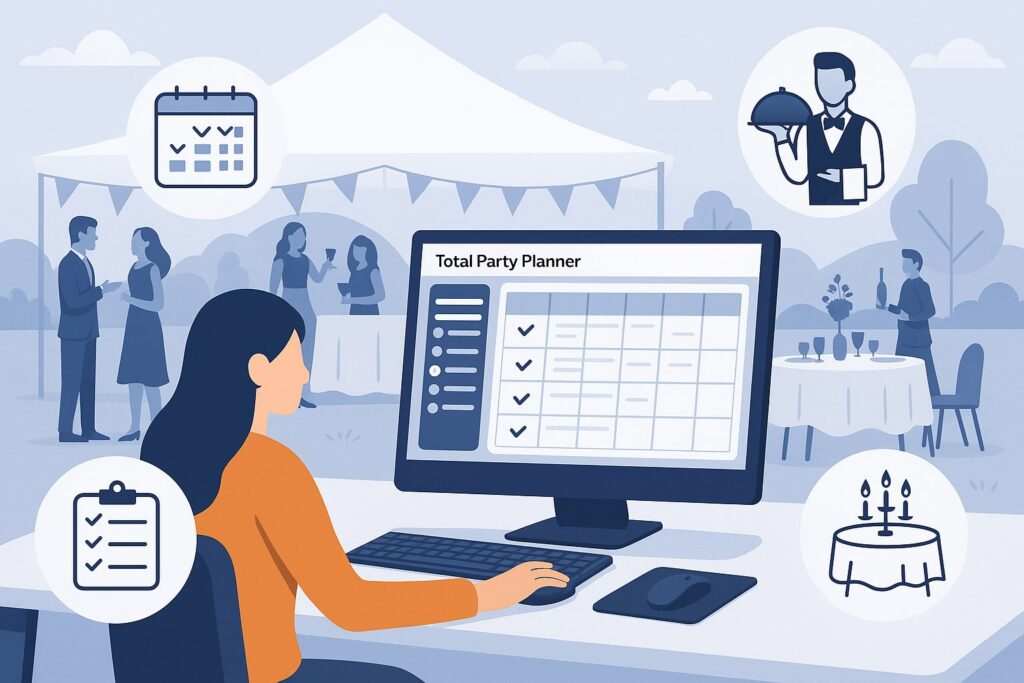
By cloudcateringmanager September 22, 2025
In today’s fast-paced food service industry, catering management tools are essential for catering companies of all sizes. Catering software streamlines operations like event scheduling, menu planning, and client communication, helping caterers stay organized and efficient.
Modern catering businesses – from wedding caterers and corporate event planners to food trucks and banquet halls – rely on digital platforms to manage everything from orders and staff shifts to billing and inventory.
In fact, the global catering software market was valued at about $3.5 billion in 2023 and is growing rapidly, reflecting the rising demand for automation and data-driven decision-making in catering.
Well-designed catering management systems empower businesses to improve accuracy, reduce manual work (like double entries), and provide better customer service by automating proposals, payments, and communications.
Key features include event planning calendars, customer relationship management (CRM), online ordering, inventory tracking, and reporting dashboards, all of which help caterers deliver seamless food experiences.
As you explore the top catering software solutions available in 2025, look for platforms that match your business needs and budget. We’ve examined and compared the leading catering management software tools in the USA market, analyzing their features, pricing, and pros/cons.
Read on to find the best catering management tool for your business – whether you operate a small mobile kitchen, a mid-sized wedding catering service, or a large enterprise handling hundreds of events.
Key Features of Catering Management Software

Modern catering management software combines multiple tools into one platform. Typical features and capabilities include:
- Event and Booking Management: Centralized calendars to schedule events, manage bookings, and avoid conflicts. (For example, platforms like Planning Pod or CaterTrax offer digital booking wizards and color-coded calendars to streamline event coordination.)
- Client/CRM Tools: Databases for storing customer information, preferences, and contact history. These let you track leads, segment clients, and send automated follow-ups. Catering systems often include proposal and contract builders so you can generate and send professional quotes with e-signatures.
- Menu and Recipe Management: Tools to build menus, recipes, and ingredient lists. Software like BetterCater or FoodStorm can auto-adjust ingredient quantities based on guest counts and create automated packing lists or kitchen production reports.
- Online Ordering and Billing: Many catering tools integrate online ordering portals or payment links, enabling clients to order and pay online.
For instance, CaterZen and CaterTrax support custom-branded online ordering interfaces, and Better Cater includes built-in payment processing so caterers can send clients payment links directly. - Employee Scheduling and Time Tracking: Solutions like Connecteam offer shift scheduling, digital time clocks (often with geofencing or photo check-in) and mobile timesheets to keep track of staff hours at events. This is crucial for mobile and onsite catering teams.
- Inventory and Cost Control: Advanced catering software tracks inventory usage by ingredient, helping prevent waste and shortage. Integrated costing engines (as in Total Party Planner or FoodStorm) automatically calculate recipe costs based on current ingredient prices.
- Reporting & Analytics: Generate sales, event, and financial reports to gain insights. Top platforms produce custom reports (e.g., sales trends, profitability by event) and can integrate with accounting software like QuickBooks or Xero.
- Integrations: Leading tools connect with other business systems. For example, FoodStorm natively syncs with QuickBooks for easy invoicing, and Caterease offers integrations to calendars (Google, Outlook), CRM (Salesforce), and payment gateways.
By automating these key tasks, catering software lets you reduce errors, save time, and focus on food and customer service. According to industry reports, 79% of restaurant operators in 2024 said that adopting technology tools (like catering software) gave them a competitive edge.
Whether your focus is corporate lunches, large weddings, festival food trucks, or on-site banquet service, the right catering management tools will help you deliver consistent, profitable events.
Top Catering Management Tools Compared
Below are some of the top-rated catering management software solutions available, along with their pricing, features, pros, and cons. We’ve organized them by type or specialty to help you find the right match for your catering business.
1. Connecteam (Best All-in-One Workforce Platform)

- Overview: Connecteam is actually an employee-management platform that many caterers use to handle staff and scheduling, rather than being exclusively catering-focused.
It offers employee scheduling, time tracking (with geofencing and photo check-in), task management, and team communication in one app. - Key Features: Shift scheduling and swaps, GPS time clock, digital timesheets, checklists/forms (for event checklists or packing lists), company knowledge base (for menus/recipes), and in-app messaging. Managers can track hours and export them to payroll software (like QuickBooks).
- Pricing: Free plan for up to 10 users. Paid plans start at $29/month for up to 30 users. (There are higher tiers for larger teams.) This makes Connecteam one of the most affordable options.
- Pros: Mobile-friendly and designed for on-the-go teams; includes built-in scheduling and communication tools so you may not need separate apps. Users praise its ease of use and responsive support. Its free tier is generous for small teams.
- Cons: Not built specifically for catering. It lacks catering-specific modules like menu management or invoice generation. You’d still need separate tools for proposals, inventory, or customer orders.
(As noted by the vendor, it’s an all-in-one work app, “not many apps make it easier for catering managers than Connecteam” on scheduling and tasks.) - Best for: Catering companies that want an affordable way to manage staff, schedules, and internal communication from mobile devices.
2. Total Party Planner (Best for Full-Service Event Management)

- Overview: Total Party Planner (TPP) is a mature, cloud-based catering/event management system built by experienced caterers. It emphasizes comprehensive event booking, menu costing, and detailed client management.
- Key Features: Robust event calendar, professional proposal and invoice templates, integrated CRM (with automated email marketing), recipe and inventory costing, and task management.
It has a client portal where customers can approve proposals and pay online. The system automatically adjusts ingredient quantities per guest count. - Pricing: Plans typically range from $99 to $399 per month, plus a one-time setup fee (around $299). (Smaller businesses often start on the lower end and upgrade as needed.)
- Pros: Exceptionally strong customer support and training. According to user reports, “fast and competent customer service” is a standout feature.
It offers detailed reporting and analytics, making it easier to track event profitability. Its pricing engine and reporting are very granular. - Cons: The interface can be overwhelming to new users, and the mobile app has limited functionality (mostly read-only calendar). Its learning curve is steep due to feature depth. The base cost plus setup fee can be pricey for very small caterers.
- Pricing Example: Starts at $65/month for the basic plan.
- Ideal for: Mid-to-large full-service caterers or event venues that run many events and need end-to-end management.
3. CaterZen (Best for Restaurants with Catering, Online Ordering)
- Overview: CaterZen by Restaurant & Catering Systems (RCS) is a catering solution popular with restaurants, delis, and chain foodservice operations. It supports drop-off, full-service, and event-space catering in one platform.
- Key Features: Full CRM and sales tools (lead tracking, proposal builder, marketing automation), mobile order-taking, delivery routing (GPS dispatch), BEO (Banquet Event Order) templates, and kitchen production reporting.
It also offers a custom-branded online ordering portal for clients to place catering orders 24/7. - Pricing: Plans start around $179/month for the Pro plan, $199/month for Pro Plus (adds online ordering site), and $229/month for Marketing Pro Plus (adds VoIP, delivery manager, etc.). An Enterprise tier is available by quote.
- Pros: Highly scalable with unlimited users and events included. All modules (CRM, sales, operations) come together, so you pay one price for a full suite.
Its custom online ordering and integrated delivery management are major strengths. Users praise its ease of use in managing orders and client relationships. - Cons: On the higher end of pricing for small caterers. Requires an annual commitment for quoted pricing. New users note it has a lot of functionality to learn. Some find the interface dated.
- Notable: Includes integrated payment processing and e-signature contracts (unlike many competitors). Thousands of catering businesses use CaterZen, and it focuses on marketing automation and retention as well as operations.
- Best for: Restaurants, catering companies, or chains that need a robust all-in-one system with online ordering and marketing tools.
4. Better Cater (Best for Small to Mid-Size Caterers)
- Overview: Better Cater is a web-based software designed specifically for catering businesses. It simplifies event creation, proposal generation, and packing list creation.
- Key Features: Unlimited customizable proposal templates, integrated calendar, automatic packing lists (BEO), online payments, and a recipe builder.
It also has a CRM database of clients and venues, and strong reporting (sales, kitchen reports). Everything is mobile-friendly via a browser. - Pricing: $69 per month (month-to-month) or $57/month if billed annually for one user. Each plan includes one user; additional users cost +$30 (monthly) or +$25 (annual) each. No setup fees.
- Pros: Extremely easy to use – users consistently mention its user-friendly interface. The flat monthly fee makes budgeting simple. It offers unlimited proposals, menus, and events with no hidden fees. Comes with unlimited live training sessions.
- Cons: Lacks a dedicated mobile app (though the website is mobile-optimized). Does not include employee scheduling or advanced task management. The proposal editor has limited customization on templates, which can frustrate some users.
- Ideal for: Small to medium-sized caterers who need a simple, affordable way to manage events, proposals, and ordering without unnecessary complexity.
5. Flex Catering Software (Best for Tech-Savvy Foodservice Operations)
- Overview: Flex Catering Software is a comprehensive, cloud-based platform aimed at caterers, restaurants, and institutions. It combines catering order management with kitchen production tools and finance integrations.
- Key Features: Unlimited menus and categories, online ordering, integrated CRM, recipe costing, dynamic pricing, and built-in inventory management. Notably, it integrates seamlessly with QuickBooks, Xero, and payment gateways, and provides real-time reporting dashboards.
- Pricing: Plans typically range from about $250 to $450 per month (depending on features and order volume).
- Pros: Strong for businesses that want automation and integration. Supports online ordering with branded portals and handles delivery routing. Users highlight its ability to sync financial data and automate accounting tasks.
- Cons: Higher monthly cost than many competitors; may be overkill for very small caterers. Some users report a steep learning curve, especially around recipe costing and use of advanced features.
- Best for: Medium-to-large caterers and institutional food services (schools, hospitals) that require an integrated system with accounting and advanced ordering.
6. FoodStorm (Best for Large-Scale and Retail Catering)
- Overview: FoodStorm is a robust catering and foodservice management solution, often used by large scale and retail caterers. It focuses on streamlined order processing and inventory control.
- Key Features: Online ordering portal, CRM, event scheduling, real-time order tracking, menu and recipe management (including ingredient-level inventory), and kitchen production reports.
- Pricing: Licensing starts at around $500 per month (quotes vary by business size).
- Pros: Very powerful order-management capabilities and integrations. Clean, modern interface favored by users. Excels at retail catering (e.g., corporate cafeterias, grocery catering). Great for managing online orders and keeping tight inventory control.
- Cons: Complex software – many features can overwhelm smaller caterers. Some find limited mobile functionality (the mobile app is not fully featured). High cost means it’s not suited for small operations.
- Best for: High-volume catering operations, grocery delis with catering, or companies that need advanced online ordering and inventory tracking.
7. Tripleseat (Best for Restaurants and Venues with Catering)
- Overview: Tripleseat is event and catering management software used by restaurants, hotels, and event venues. It integrates with existing POS systems to manage event business.
- Key Features: Event booking calendar, CRM, proposal and contract management, banquet event orders, and reporting. It also offers guest management and lead capture forms for events.
- Pricing: Approximately $4,500 per year (about $375/month) for a single license. Pricing is generally quoted per venue.
- Pros: Tailored for hospitality venues – very strong at managing event bookings and inquiries in a restaurant or hotel setting. Industry-leading CRM for event planning. Users appreciate its ability to connect front-of-house and back-office seamlessly.
- Cons: Expensive for small operations. Not ideal for standalone catering companies (it’s designed for venues managing catering as part of overall events). Some learning curve.
- Best for: Banquet halls, hotels, and restaurants that frequently host catered events and need venue-centric software.
8. Caterease (Best for Event-Heavy Catering Businesses)
- Overview: Caterease is a veteran desktop and cloud catering software solution that excels in detailed event booking management. It’s widely used by caterers and event planners for its robust event-oriented features.
- Key Features: Flexible event management wizards, centralized calendar with color-coding, drag-and-drop menu builder, extensive reporting, and automatic packing lists.
It includes recipe and inventory management, and can generate PDFs like BEOs. It also offers integrations with accounting, calendar, and mailing tools. - Pricing: Tiered subscription. Plans range from about $65 to $130 per month (higher tiers include more features), plus a one-time setup/licensing fee ($500–$1000).
- Pros: Excellent for managing multiple complex events. Users praise its scalable recipe costing, drag-and-drop menus, and detailed booking wizards.
The calendar and staff scheduling tools are very mature. Integrations include QuickBooks, Google Calendar, Mailchimp, and more. - Cons: The interface looks dated by modern standards. Some users report bugs (e.g. tax calculator issues, glitchy inventory). Support can be slower as it’s more of a legacy product.
- Best for: Catering businesses and event managers who run many events per year and need a proven, thorough system for bookings and logistics.
9. CaterTrax (Best for Institutional and Large-Scale Catering)
- Overview: CaterTrax is a comprehensive web-based catering software, especially popular in North America for institutions like schools, hospitals, and corporate food service. It offers robust back-office tools tailored to large operations.
- Key Features: Online ordering portals for customers, integrated inventory control, robust reporting, and web-based admin tools. Also offers nutrition and label printing modules for institutional use.
- Pricing: The basic plan is about $150 per month (pricing is “per feature,” so cost scales with added modules).
- Pros: Enterprise-level scalability. Streamlines complex order workflows and inventory. Supports 20,000+ users, indicating a strong track record.
- Cons: Not easy to self-implement – typically requires professional setup and training. The UI is not the most modern.
- Best for: Large-scale caterers (e.g. university dining, corporate cafeterias) needing a heavy-duty, fully-integrated system.
10. UpMenu (Budget-Friendly Online Ordering for Restaurants)
- Overview: UpMenu is actually a generic online ordering platform aimed at restaurants, not a full catering solution. However, some small caterers use it for budget-friendly online ordering and basic menu management.
- Key Features: Mobile-friendly online ordering website and app, menu builder, e-marketing tools (promotions, loyalty).
- Pricing: $49–$169 per month depending on features.
- Pros: Very affordable for online ordering. Easy to set up and get started. Good for caterers who mainly need a simple takeout or drop-off ordering site.
- Cons: Lacks catering-specific features like event scheduling, proposal generation, or packing lists. You’d need other tools for full catering management.
- Best for: Small restaurants or caterers who primarily offer drop-off catering and want a cheap way to accept orders online.
Frequently Asked Questions
Q.1: What is catering management software and what does it do?
Answer: Catering management software is a specialized business tool that centralizes all catering operations – from event booking and menu planning to client management and invoicing.
It automates tasks like proposal generation, digital menus, kitchen production sheets, and online ordering, helping caterers run events smoothly and scale their business.
Q.2: What features should I look for in catering tools?
Answer: Look for event/calendar management (to avoid double bookings), online order portals, automated proposal/invoice generation, and inventory/recipe costing.
A built-in CRM to track client history, as well as integrations with accounting or payment systems, are also important. If you deliver food, features like delivery routing and kitchen production reports can be very valuable.
Q.3: How much do catering management tools cost?
Answer: Pricing varies widely. Some tools have free or low-cost entry plans (e.g. Connecteam’s free plan for 10 users, UpMenu from $49/month).
Others can be several hundred dollars a month. For example, a basic Total Party Planner plan starts around $65/month, while Tripleseat is roughly $4,500/year. Always check each vendor’s pricing page or ask for a quote.
Q.4: Do I need a separate scheduling app or can catering software handle staff scheduling?
Answer: Many catering platforms include scheduling for cooks, servers, and event staff. For instance, Connecteam has employee shift scheduling and time clocks built in. However, not all tools offer this; some focus purely on orders and events. If your software lacks scheduling, you might pair it with a standalone scheduling app.
Q.5: Can catering management tools integrate with other software?
Answer: Yes. Leading tools integrate with third-party systems. For example, FoodStorm and Flex Catering link to QuickBooks or Xero for accounting.
Caterease integrates with Google/Outlook calendars, Salesforce, and payment gateways. These integrations help maintain one flow of data across your POS, accounting, and marketing systems.
Q.6: Are there free catering management software options?
Answer: Some free or low-cost options exist. Connecteam offers a free-for-life plan for small teams of up to 10 users. UpMenu has entry-level plans that act like basic ordering tools. Often these free tiers have limited features, so they may suit very small or new caterers who can operate with simpler tools.
Conclusion
Choosing the right catering management tool depends on your business size, service model, and budget. Small catering businesses or startups may opt for affordable, user-friendly platforms like Better Cater or the free tier of Connecteam to handle proposals and staff scheduling.
Mid-sized caterers often benefit from specialized systems like Total Party Planner or CaterZen, which include CRM, menu costing, and online portals. Large, enterprise-level caterers and institutions might require the advanced integrations and reporting offered by solutions like Flex Catering or CaterTrax.
Key considerations when evaluating tools include ease of use, mobile access for on-site teams, integration with accounting systems (e.g. QuickBooks), and the availability of customer support. As one source notes, “the right catering software in 2025 comes down to balancing cost, online ordering, and operational needs”.